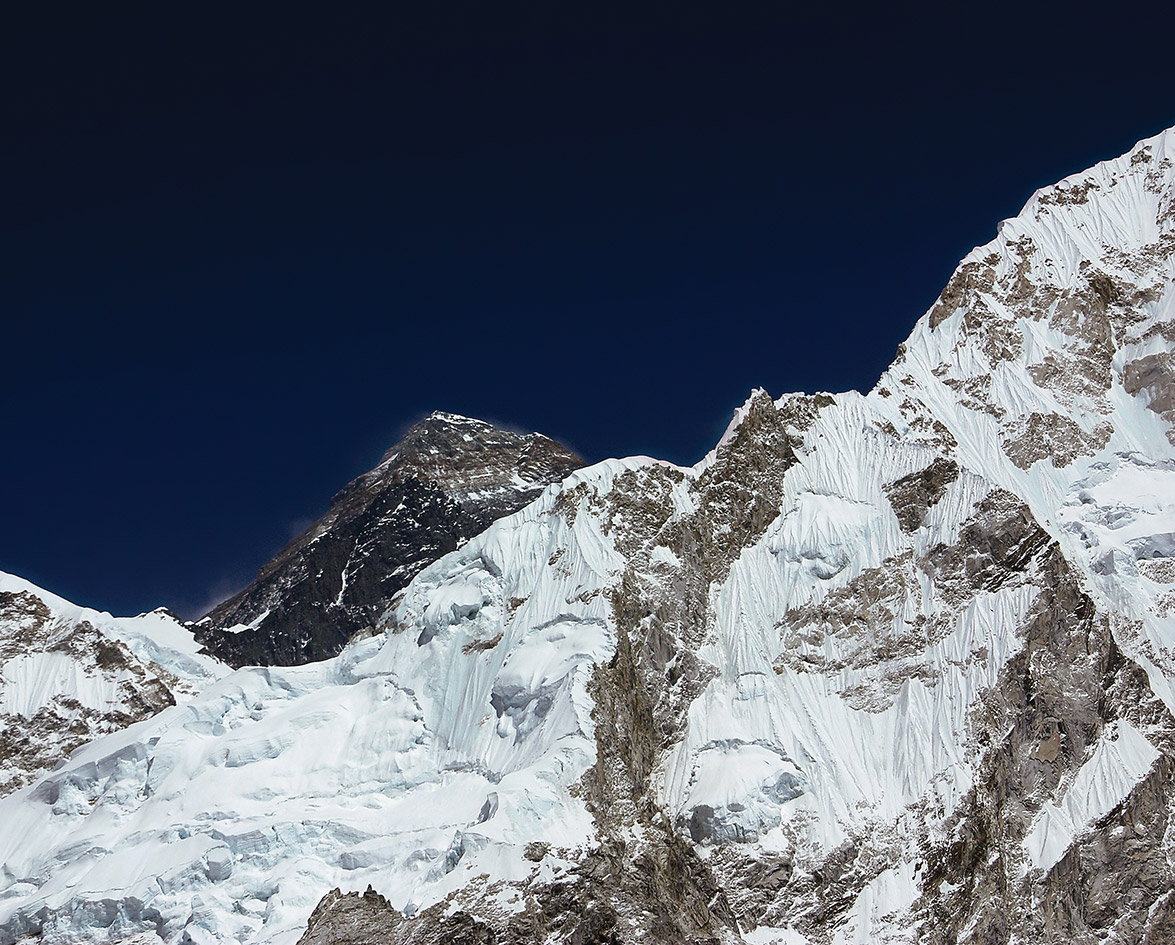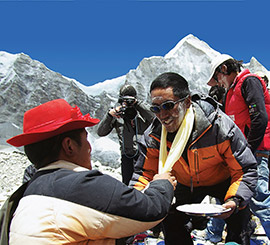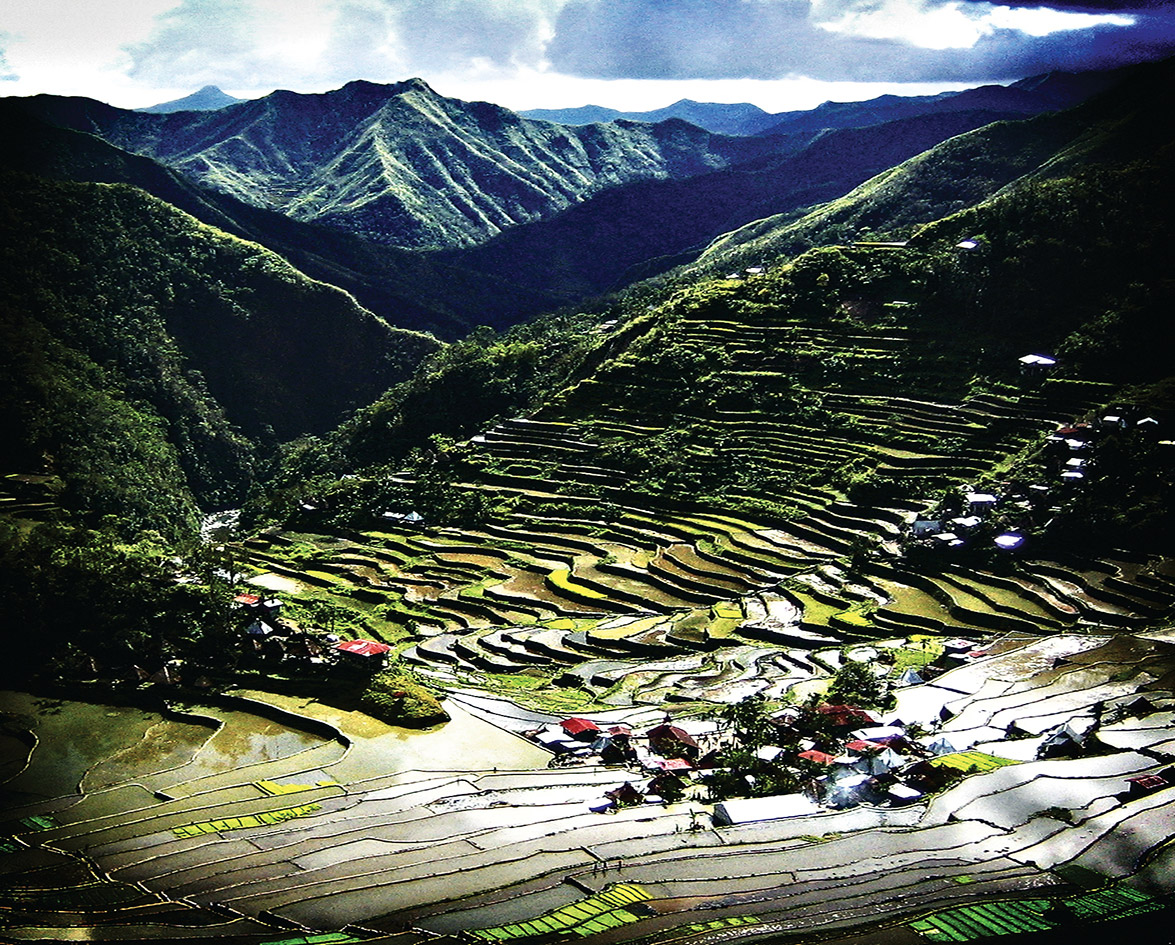The windless day provides a spectacular view down onto the snow-covered peaks of Makalu, Kanchenjunga, Cho Oyu and Lhotsi—four of the tallest mountains in the world. Clouds are forming over the plains of Tibet, more than 8,000 metres below. It is 9:30 am May 25th, 2008. Twelve hours after leaving Camp IV, Brian Jones, John Furneaux and Sébastien Sasseville, along with four of their Sherpa teammates, have finally reached the summit of Mount Everest.
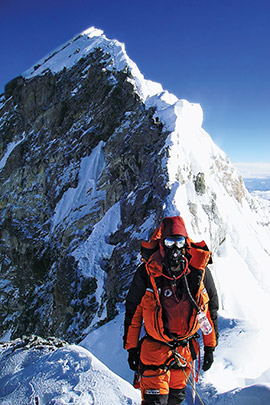
The May 2008 trip was the first Everest attempt for each of the Canadian men. Canada West Mountain School owner and operator Brian Jones started planning this trip in March 2007 with Rob Hill.They have been working to reach the highest summits of each continent to raise awareness for Crohn’s disease and other intestinal illnesses. Hill has successfully climbed six of the seven summits, and Everest is his final challenge. Along with Jones and Hill on this trip were four other climbers: Sébastien Sasseville from Montreal, who became the first Canadian with type 1 diabetes to summit Mt. Everest; Darrel Ainscough, a Canada Post worker who has climbed four of the seven summits; Erik Bjarnasson, a firefighter from North Vancouver who lost nine of his fingers on Mt. Logan and is encouraging and inspiring people with mobility issues to get out into the mountains; and Wayne Browning, a 71-year-old from California who loves to climb. John Furneaux joined Jones as a guide; Dave Sarconey came along as Hill’s videographer; and eight trekkers (mostly friends and family of the climbers) accompanied the team to Base Camp.
Planning The Excursion
When putting together a trip that will last more than two months, it is vital that team dynamics are positive. Team members do not always meet each other before trips although they are encouraged to attend training sessions. Most of the climbers taking part in the 2008 Everest expedition also climbed Cho Oyu together in the spring of 2007. Before leaving, everyone trained hard, some of them in unexpected ways. “My biggest training of all was eating! I had a mission to gain as much weight as I could before Everest, which is quite hard for me,” explains Sasseville. “I have been to Nepal many times and lost a lot of weight from high altitude mountaineering. In the end, I gained 10 pounds and lost close to 20.” Each individual had his own way of getting fit: personalized gym workouts, cycling, snowshoeing and hours of skiing. While Jones says he would not suggest scrimping on physical training, it isn’t the most important part of the slow climb—the acclimatization tends to be a bigger issue than strength. The majority of the logistics for their trip were taken care of by Himalayan Guides Nepal, a company based out of Kathmandu. Iswari Poudel, the Managing Director, flew to Vancouver to meet with Jones and arrange the specifics of ground support, including transportation, porters, Sherpas, food and gear.
Beginning Their Trek
They made their way individually to Kathmandu at the end of March 2008, and on March 27 they flew as a team to Lukla to begin the nine-day trek to Base Camp. They hiked for five or six hours each day, stopping in the evenings to explore the villages they passed through.
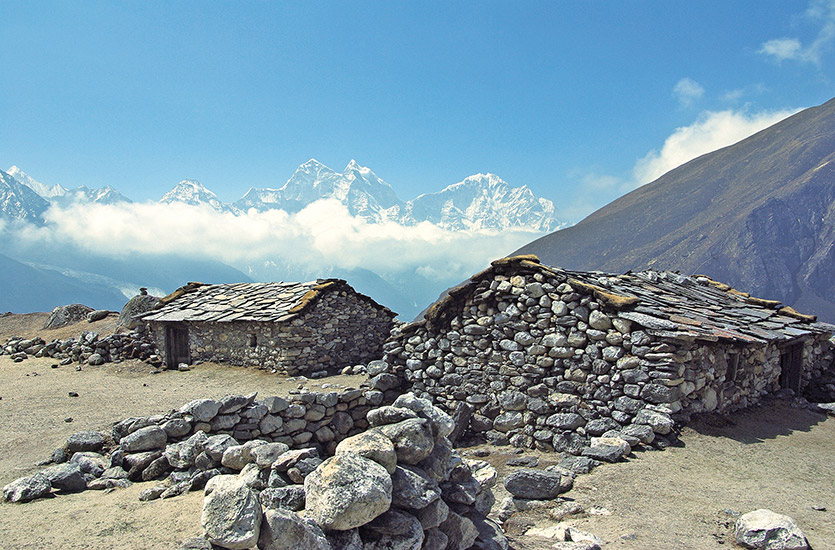
They stayed in tea houses along the way and were enchanted by the hospitality of the Sherpa families and Nepalese people they met on the roads. There were no cars, but they often had to wait in traffic of yaks and porters going between villages with supplies. They stayed no more than a night in most villages, but spent three days each in the larger towns of Namche Bazaar and Dingboche in order to properly acclimatize. It was in Namche Bazaar that they caught their first real view of the great Sagarmatha, the Nepali name for Everest. “There’s a reason people have attributed the Himalayas as a place of the gods. It’s inhuman. There is so much energy, but it has nothing to do with the people. The people there are humble. They are very accepting of the mountains, and not fearful.” Jones’s first view of the mountain gave him the feeling that it was doable, but he was impressed by the sense of power and history.“ You really realize where you’re standing and how many people have stood there before, looking at the same view and really, nothing has changed up there.” For the last leg of the climb in the higher altitude, the team had seven Sherpas. Sherpas do more than carry gear—because of their extensive knowledge of the mountain they are heavily involved in the planning and decision-making process.
There is a mix of Buddhism and Hinduism in Nepal, and most of the Sherpas follow one of these religions. Because of this, many of them will not take anyone who has not been blessed past the ice falls. So on April 13, Jones and his team gathered around a sacred fire and raised prayer flags. All of the team members, along with the gear, food and supplies, were blessed by a lama, a Buddhist holy man, in a traditional puja ceremony. After this it was just a matter of acclimatizing by making trips up and down between base camps. During the wait time, both Hill and Browning had to leave the team due to health issues. Once the rest of the team was ready, and permission was given to go above Camp III, they headed for the summit. They left Camp IV (7,960 metres) at 8:45 pm on May 24.
Point Of No Return
At around 8,250 metres both Ainscough and Bjarnasson decided to turn around, feeling it would be unwise, and potentially dangerous, for them to continue past this point. The risks associated with the altitude and cold are serious, and recognizing that is the best way of preventing tragedy. Jones, Furneaux and Sasseville continued on with some of the Sherpas, reaching the summit of Mount Everest at 9:30 am on May 25. They spent half an hour watching the sun work its way higher into the sky, taking pictures and celebrating their accomplishment. The four-and-a-half hour descent was uneventful. Everyone made it back to Kathmandu, and subsequently home, safely. When asked about their favourite parts, they all agreed that the expedition was an incredible experience. For Furneaux, the best part was that everyone came home with great memories and no close calls. “Whether we sat on the summit or made it to Base Camp, the number one goal is that we have fun and return to our loved ones.” Climbing the highest mountain in the world is an adventure filled with physical challenges, but also with kind, generous people, cultural experiences and amazing views. It does not take superhuman strength or amazing technical abilities—if it’s something you want to do, you just need to have the drive and the patience to make it happen.





